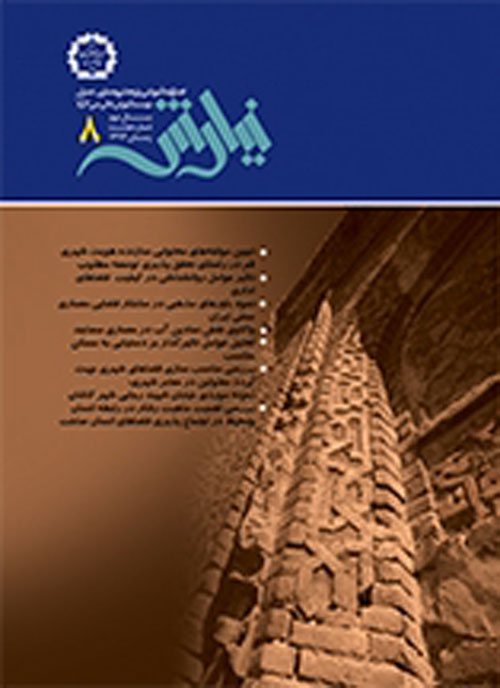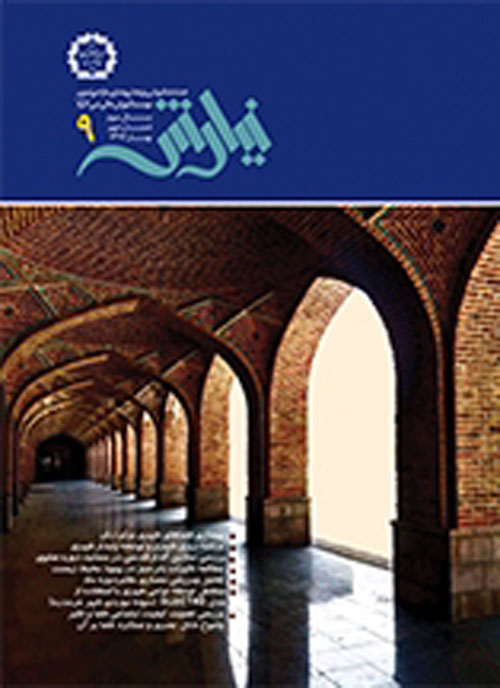فهرست مطالب

فصلنامه نیارش
پیاپی 8 (زمستان 1393)
- تاریخ انتشار: 1397/12/25
- تعداد عناوین: 8
-
صفحه 80
-
Page 5The transition from the industrial age and the growing impact of the global economy on human life which led to rapid expansion of western urban design culture in countries like Iran, are among the reasons why nowadays only remains a memory of our traditional cities. At this regard, urban identity is one of the most important and controversial issues among urban designers and other professionals involved in urban studies. Qom, as one o f the important religious cities of Iran which hosts a great number of Muslims every year from all over the world, is a city which turned into a base for expanding Islamic culture and extending religious thinking from the beginning of entrance of Islam to Iran. The matter that should be mostly considered by the policymakers, urban designers and urban planners of Qom shall pay attention to religious thoughts and believes of people of this city as important subjects. The subject which is located in a higher position than geographical situation and structural elements of this city and provides the necessities of accomplishing an ideal development for this city.Keywords: Urban identity, Qom, Religious city, Spirit of place
-
Page 12Man is always in contact with the built environment and architecture, therefore spends much of his time in architectural spaces. These places have great influence on the human psyche and the sense of space and users comfort. Architectural spaces must be designed based on spatial psychology and their effect on human excellence and performance. The aim of this study is to investigate the effect of psychological factors on quality of the office space. Using descriptive methods, in this paper these factors firstly identified then their effect on man is discussed. Results showed that, not only factors such as color, dimensions, proportions, opening arrangement, beautiful frontage and overall good architecture as well as its proper function in that space affect the efficiency of staff, but also the behavior of managers in working environments could significantly reduce the burden of work and occupational stress.Keywords: Office spaces. Psychological Factors, Employee Operation
-
Page 21Architecture of any land is crystallized and manifested from ideas, beliefs, culture and identity of its people. After the acceptance of Islam, Iranian people have adapted its principles in their own lives and traditions, which mean they have not generally, bypass their folklores and way of life, but if it was necessary they have adapted and changed them with the centrality of teachings of Islam. The purpose of the study is the impact of Iranians` beliefs, religious beliefs and culture on the spatial structure of Islamic-Iranian architecture, especially house. This study is based on descriptive-analysis method. Data has been collected by two main methods evidence and field method. In the evaluation of this study that is taken as a case study that focused on traditional architecture, some of the brilliant aspects of manifestation of religious beliefs including privacy expression and permeability fields, separation of fields (private and public), tribute to guest, confidentiality and etc are visible in spatial structure of the Traditional houses. Each of these principles has led to useful features and usages in the spatial structure of traditional houses and also has led to comfortable life of traditional human.Keywords: Traditional Architecture, Religious Beliefs, Culture, House
-
Page 34The procedure of granting meaning to the nature lasts as long as the human life. The human being at different parts of the terrestrial globe and with regard to his historical situation has given the identify to the nature elements. At the beginning, the man’s apprehension of the environmental phenomena was a reaction to meet his vital needs. Due to the dependence of world on water, in most of the cultures and civilizations water has been regarded as a crucial element. And by the passage of time, the respect toward the water and its admiration as a part of human life and cultuer amost the historical factors shaping the human mind, religion and its various dependant forms such as myth and custom have played important role Architecture, in an interpretation is a phisican response to the man’s need or ideals from the most naïve to the most exalted. And architecture is a worthy model of giveng physical response to a natural need. So, water has been an element in creation of architecural space with religious, cultural andsocial funtions. Water is an element used mysteriously in Iranian- Islamic architecture in its exact place and according to its true existence. The mystery of water in this type of architecture is themirror of univrse and transmutation of the world of substance in allegorical faces. Water and its myths brought about a situation through which the Iranian architec manifests his/her respect to and admiration of this element in its different forms. Therefore, the reflection of symbolic concepts of water in the architecture of Iranian religious monuments has been considered in order to recognize the role of metaphysical beliefs and their influences on the representation of those thoughts in Iranian architecure. The present study intends to exploit both the field and library studies to reconsider the symbolic concepts of water at Iranian religious architecture and give reflective instances of presence of the water at religious monuments (Iranian mosques).Keywords: Mosque Architecture, Water, Symbol
-
Page 45House as a shelter is one of the primary rights and the most essential human needs, and all the people of society regardless of race, sex, social class and ethical background should have access to a suitable house. This kind of approach to housing creates the social justice concept in the mind. In this regard, achieving such housing that provides healthy life for citizens creates affordable housing concept. Affordable housing implies residential space that has all quantitative and qualitative indicators for having suitable and healthy settlement for citizens. Suitable shelter is not only a ceiling over person’s head. Suitable shelter means having all the amenities and facilities necessary for healthy human life. Therefore, in order to obtain affordable housing; households should spend less than 30 percent of their annual income. In this paper, with descriptive and analytical method, the housing challenging factors have been investigated and also affordable housing causative factors and indicators have been analyzed.Keywords: affordable, housing, influential factors
-
Page 54Urban streets have a special value in urban development programs. This is due to the impact of these spaces in strengthening the cultural dimensions and have social stability and production of social capital. Sustainable development of the city, in the sense of realizing the aspirations and needs of all members of society. Disabled people have the same rights similar to other citizens. The aim of this study is evaluation of urban spaces for disabled people in the Rajayi Street in Kashan, located in the city center and is one of the most crowded streets of the city. The methodology of this study includes survey, which its data has been collected through field observations. For this purpose 32 indicators to assess the current situation and the compatibility of the desired status was studied. The results of research suggest that the path for pedestrian circulation is not suitable specially for disabled. The most obvious problem was observed the vertical guardrails mounted by municipality in sidewalks and street, so it is recommended to provide wheelchair path.Keywords: Urban Streets, Disabled People, Kasha
-
Page 72Human beings are not isolated from their surroundings and are interacted with at every moment. In addition to being physically interacted with the environment, they are emotionally and psychologically connected too. Human activities on the environment are a complex system of different categories and have been addressed by different theoretical approaches. These approaches are common in focusing on the concept of the quality of life in man-made environment and it reveals the necessity of addressing the affordance of man-made environment. The possibility of establishing good social interactions at different levels of family and society, man-made environment on one hand and the possibility of understanding the nature and natural elements on the other hand, indicates two aspects of quality of man-made environment. This research is intended to analyze and assess the role of perception of nature and natural elements in man-made environment on the sociability of physical environments of daily life and the desire to interact with the environment. Therefore, based on environmental psychology literature and behavioral sciences, the basic framework is subtilized on context of humanenvironment studies and components affecting human interaction and the natural environment in the physical environment are investigated. In the following the sociability of physical environment in interaction with the natural environment is analyzed and evaluated. In this paper, as a result of investigating the above mentioned factors, the perception of nature in manmade environment was found as one of the effective factors of sociability in physical areas.Keywords: Human, environment, behavioral sciences, environmental psychology, nature perception


